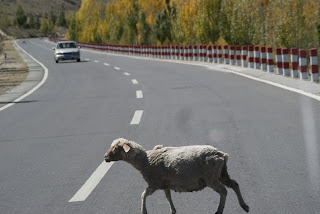01 Raft, Li River
02 Raft, Li River
03 Laundry, Li River
04 Man with birds, Li River
05 Water Buffalo, Li River
06 Air Conditioners, Hong Kong
07 Mao and his Friends, Hong Kong
08 Signs, Hong Kong
09 Crazy Taxi Cab dashboard,
10 Me and Winnie!
12 Weeks across 7 Countries, 1 Special Administrative Region and 1 Autonomous Region
01 Raft, Li River
02 Raft, Li River
03 Laundry, Li River
04 Man with birds, Li River
05 Water Buffalo, Li River
06 Air Conditioners, Hong Kong
07 Mao and his Friends, Hong Kong
08 Signs, Hong Kong
09 Crazy Taxi Cab dashboard,
10 Me and Winnie!
00 The sunrise over the Tibetan Plateau, between Golmund and Lhasa

01 Around 5000m, the highest point on the trip, between Golmund and Lhasa

04 Traditional Tibetan Architecture, Barkhor district, Lhasa


 09 We had to stop a lot for cows and sheep, between Tsedang and Lhasa
09 We had to stop a lot for cows and sheep, between Tsedang and Lhasa 10 I think this is a yak, but it could be a bull, or some sort of mix between the two, between Tsedang and Lhasa
10 I think this is a yak, but it could be a bull, or some sort of mix between the two, between Tsedang and Lhasa 11 Nightclub performers, Lhasa
11 Nightclub performers, Lhasa
This has been a week in transit as we have been making our way west to
Boarding the train was pretty easy for two reasons: they use our number system, and I took a photo of my train ticket and emailed it to Wade, Dafeng, Brooke and Jamie with the note “what does this say?”. Isn’t technology amazing? Despite our efforts to pump ourselves up for the train, it was a rough night. The car was packed: every seat was taken and there were people standing as well. The ends of the cars were even more packed as people crammed in from when the train made stops. Even though there were “no smoking” signs posted, the conductors didn’t seem to enforce it. A group of kids played a radio almost the entire night. We made friends with the girl sitting next to us who had a 15 hour train ride ahead of her. Another guy came along about 6 hours into the ride who wanted to be my friend because I spoke English. He had a 12 hour ride standing, which he didn’t complain about once. If he could do it, I could suck it up despite my back starting to ache and not wanting this to be my first encounter with a public eastern toilet. When we got off the train, there were people sleeping in the aisle that we had to step over with our 20kg of luggage, one guy was asleep under the benches with his head under one bench, butt in the aisle, and legs under the bench on the other side of the aisle. We got off in Pingyao at
The city was very interesting. PIngyao’s wall still fully encloses the old city. It was a financial center until the 12th century or so when it fell into poverty. Because of that its main streets were preserved and never modernized. Although most of the things there cater to tourists, the buildings are more or less original and very interesting to see the life of a medieval town. They had temples, houses and banks that you could tour that were restored as they were in medieval times. We were able to walk on top of the wall which provided interesting glances into current house courtyards. Lots of wash hanging, we saw a recycling place with an enormous pile of plastic bottles and a neatly arranged wall of green glass bottles. We made friends with 2 swedish guys at our hostel who we took another golf cart to a temple about 7km outside of the city. As interesting as the temple was seeing the everyday street life taking place on the way. There were older men playing cards on the sidewalk, fruit stands, street vendors selling dumplings, and many families on their mopeds, honking and beeping through city traffic.
We met a lot of interesting travelers at the hostel we stayed at. A guy from the Basque country trying to figure out how to get to
We left Pingyao on a 20 hour train ride to
1: City Wall, Pingyao
3: West Gate wall entrance at night, Pingyao
4: Our taxi/golf cart driver through a lane of trees, outside Pingyao on the way to 
5: I’m getting really good at my secret photo shots, we opted not to get this photo done of ourselves, Pingyao
6: View from the train, en route to 
7: My sleeper compartment-mate, en route to Lanzhou
2: London Graffiti, Shoreditch
 3: Teaching their son how to worship, holding incense, at Lama Temple, Beijing
3: Teaching their son how to worship, holding incense, at Lama Temple, Beijing 
 5: The Great Wall at Badaling
5: The Great Wall at Badaling 

